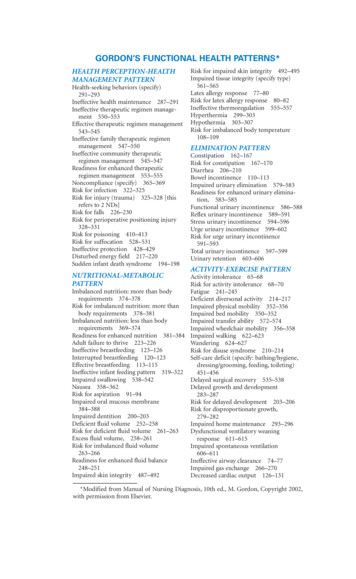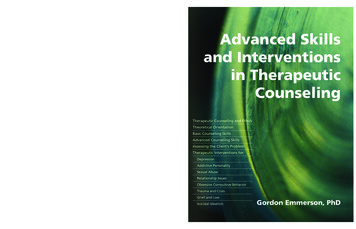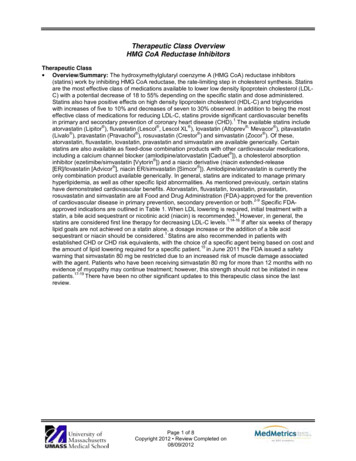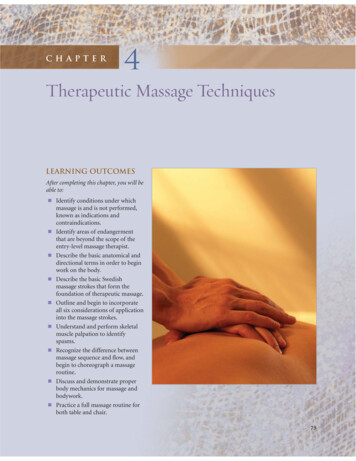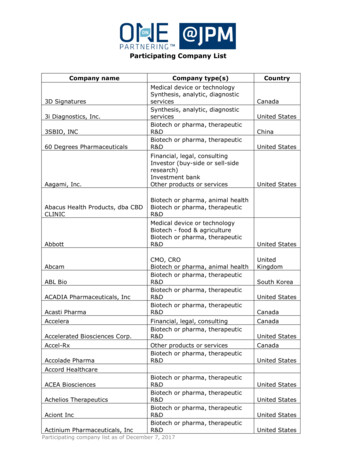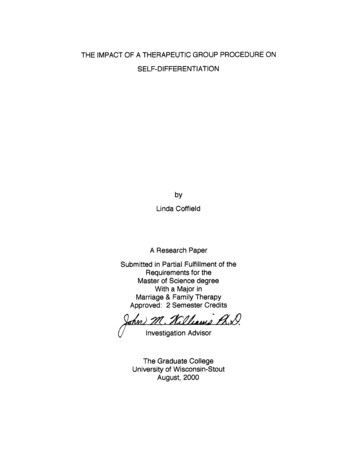
Transcription
THE IMPACT OF A THERAPEUTIC GROUP PROCEDURE ONSELF-DIFFERENTIATIONbyLinda CoffieldA Research PaperSubmitted in Partial Fulfillment of theRequirements for theMaster of Science degreeWith a Major inMarriage & Family TherapyApproved: 2 Semester Credits(/Investigation AdvisorThe Graduate CollegeUniversity of Wisconsin-StoutAugust, 2000
The Impact of a Therapeutic 2ABSTRACTCoffield, Linda, M.The Impact of a Therapeutic Group Procedure on Self-DifferentiationMarriage & Family Therapy, Dr. John Williams, 8/00, 37 pagesAPA formatSelf-differentiation and healthy boundaries have been associated with theability to maintain healthy stable relationships. According to Murray Bowen, adominant force since the 1950s in developing a family systems therapy model,relational difficulties presented in therapy are often related to an individual's lack ofdifferentiation and overly rigid or weak boundaries (Nichols & Schwartz, 1998). Thequestion then arises, "If self-differentiation is desirable, how does an individual acquireit?" Bowen proposed that psychotherapy could produce moderate increases in aperson's level of differentiation as well as by intentionally addressing personalintergenerational issues (Bowen, 1978; Kerr & Bowen, 1988). Others maintain thattherapy as well as crises throughout our life in marriage, family life, friendships andcareers are able to raise our levels of differentiation (Schnarch, 1997). This researchwill seek to discover whether a group procedure for individual development on healthyboundaries will positively impact the participants' levels of differentiation.Bowen's theory has always centered around togetherness and individuality withemotional health involving a balance of these two forces (Nichols & Schwartz, 1998).Unbalance in the direction of togetherness is called fusion or undifferentiation.Differentiation is both the ability to separate feeling from thinking in a balanced wayand to react emotionally towards family and others in a balanced rather than extremeway. A differentiated person is able to take definite stands on issues because s/he isable to think things through, decide what s/he believes, and then act on those beliefs.
The Impact of a Therapeutic 3This enables her to be close to others without being overly shaped by them (Nichols &Schwartz, 1998).Healthy boundaries, according to clinical Psychologists, Dr. Henry Cloud andDr. John Townsend (1992), are often confused by our family of origin or other pastrelationships. They believe that healthy boundaries can be learned and acquiredeven later in life. Cloud and Townsend contend that healthy boundaries result infreedom, a knowing of what, who, why, and how we are responsible for what lieswithin our boundaries. This leads to free choices of how we feel, think, act, believe,and relate to others rather than feeling controlled, or out of control with them. Thisresearch utilized Cloud and Townsend's work to lead the group procedures on healthyboundaries.The Differentiation of Self Inventory (DSI) was given to the subjects prior to thenine week group and at the conclusion of the group. The pre and post inventory resultswere compared to see whether individuals' levels of differentiation were impacted bythis group procedure. The research found this Boundaries group significantly andpositively impacted the scores on the DSI of each individual who remained in thestudy. It may indicate that this cost and time effective group process is a beneficial wayto supplement individual or family therapy and perhaps is a method of choice for anindividual to work on improving their self-differentiation.
The Impact of a Therapeutic 4Table of ContentsTable 1-Research & Control Group Statistics.6Table 2 Means of past & present emotional issues/Prior & present counseling history . .7Table 3 Drop out statistics . 7Introduction . . 8Factors Impacting Em otional Health.8The Process of Self-differentiation.9Healthy Boundaries in Relation to Differentiation . 10Research Instrum ent - DSI .11Statem ent of the Problem . 11Research Hypothesis.13Assum ptions & Lim itations.13Literature Review-Introduction.14Self-Differentiation . 14Psychological boundaries in relation to self-differentiation . 17Groups prom oting change.20Group therapy's impact on boundaries & self-differentiation . 22Testing self-differentiation.23Research M ethod . 24Null Hypothesis . 24Subjects.24Relationship between research method & null hypothesis.26Instrum ent-Differentiation of Self Inventory.27Data collection & analysis . 28
The Impact of a Therapeutic 5Control of variables.Results .Discussion . 28.29. . 30Conclusions & Implications for the Field.32Appendix 1 Differentiation of Self Inventory . 34Appendix 2 Research Participants' Demographics.35References . . 36
-n imj-o1m a I-ioI0-niR:;3iC,,.E, :o:i "-0Im3 !0o o qti! ri'i —i0ii iij l lxbli iOii il lx 1i iiii i i i nImIfI I Illlli1lliil!llc 1 1 1 1 1l !ii( IlIijiiiliiiI ilib liiIIiiv -iii iigllI lllI l l li: IOJ[" Ix:0Oriiiil''T i.IC!-/I i!0l10§ l0·I)IIoI{C[o oo [ ooo !- IN IINIJ){[ I iiini l i,IIIIilllIl0 x)" ' /i. lo)CDlloo lr\) 1lII-ri } iiIrn [wINIIII 1 1-1I 1I0 1IiIq/ioi!i ,"o !iIINiT IO1 PIN{ ,'i!0I' , l l l l l l ! [ l{i"3i I:[-' --- 'i}-i0.iii[i0HlliiiA-AI 0l I liLi.1 In 1 1 1 1 1 1! i i0i [ lU- l il l1.- 1 1iUl iliio '( ;:::0IiiIi'-IE lliii0iiNiiniIi0 I iiiwijCD 10000 0i!I}mi'73iii{! {i -8» ii {Hlo1{{ '5'-i [I --.[0)i i i i i ' l i i 103 iii iJ}){
The Impact of a Therapeutici' ' ,,,,,-"L'S -E . . .MEANS OF PAST & PRESENT EMOTIONAL ISSUESPRIOR & PRESENT COUNSELING HISTORY7I iis iTABLE, ,-;-i.- . . . .'. . . .,. .S2 E ETABi PRESENT ISSUEX 2.5Significance betw. research/controlgrp.pi .05PAST ISSUES----------- l --.--------.---- 5 . .J EA - - --- --r---------O-------RESEARCH GRP X 4.5CONTROL GRP. X 2.5X 1.25DROP OUTSX 4.7 X 3.6.----.- -.----.T-.-.-"-.-.-.- ------.--.-.-.---.---.-L.---IPAST COUNSELL PRES. COUNSEL.RESEARCH GRPi3 YES1 NCONTROL GRP. 1 YES 3 NODROP OUTS 4 YES. 5 NO.----1 YES 3 NO.i1 YES, 3 NO1 YES, 8 NO-------'.L.------------i--------------. .---.- ----.TABLE 3 . .DROP OUT STATISTICS--.-.RAW SCOREX 3.09PASTISSUES .X 4.7.,,,,. . .----PRESENT ISSUE X 3.6PAST COUNSELi 4 YES, 5 NOPRES1 YES.8 NO--- -----------PRESC. . COUNSEL-.,. . . .
The Impact of a Therapeutic8The Impact of a Therapeutic Group Process on Self-differentiationIntroductionSeveral factors impacting emotional health are reviewed in this section.Bowen's concept of family systems and self differentiation, and Cloud and Townsend'sconcepts of healthy boundaries are discussed as key factors in attaining emotionalmaturity and health. Various ways to increase self-differentiation are reviewed. Groupprocedures for individual development is discussed as an option for impacting selfdifferentiation. Cloud and Townsend's work on healthy boundaries is related to theBowenian process of differentiation. Their group process materials are described asthey were a main tool utilized for this research. The benefits and rationales for using agroup process for this research are discussed and finally, the assessment tool, TheDifferentiation of Self Inventory, is briefly described as a valid and useful tool used inthis study.Factors Impacting Emotional HealthMany factors have been found to impact individuals' emotional and mentalhealth and their capacity to have mutually rewarding relationships with others. Theability to bond and attach with others is a key factor. Others include: self-confidenceand high self-esteem; the ability to comfortably socialize with others; having access toencouraging and supportive family, friends or mentors; and many more (NMHA MHIC,5/00). Some individuals are more fortunate in their early acquirement of the abovecharacteristics, others struggle with these their whole life. Every individual as an adult,however, is left with the business of working through their own family's patterns ofthinking, acting, believing, and communicating that perhaps hinder healthyrelationships. In a variety of psychological literature self-differentiation and healthyboundaries have been found to be key factors in an individual's ability to maintainhealthy stable relationships.
The Impact of a Therapeutic9The Process of Self differentiationAccording to Murray Bowen, a dominant force since the 1950s in developing afamily systems therapy model, relational difficulties presented in therapy are oftenrelated to an individual's lack of differentiation and overly rigid or weak boundaries(Nichols & Schwartz, 1998). Bowen saw all people as beginning life as part of anundifferentiated ego mass - the family. Over the course of time, in order to beemotionally healthy he believed we must differentiate, learning to establish our ownidentity and separating ourselves out from our family (Foley, 1974).Bowen believed that most children emerge from their families with relatively thesame level of differentiation as their parents. He called this the multi-generationaltransmission process where the transmission of differentiation follows a pattern acrossgenerations. He also believed that a person's level of differentiation is a relativelyfixed trait, taking a long time to change. He saw a family's quality of communication asa product of the family members' levels of differentiation. This led to him believing thata family's communication was unlikely to permanently improve until their levels ofdifferentiation improved (Nichols & Schwartz, 1998). The question then arises, "If selfdifferentiation is desirable yet resistant to change, how does an individual acquire it?"One of the methods Bowen saw as helpful to the process of differentiation waslooking at the multi-generational family history. As a person recognizes the unhealthypatterns of which they are just one link, they can gain the perspective necessary tobreak the chain and begin the differentiation process. Bowen also proposed thatpsychotherapy could produce moderate increases in a person's level of differentiationby helping an individual de-triangulate from others within his family (Foley, 1974).According to Bowen, when a relationship between two people in a system getsuncomfortable, one of them will triangle in a third party, relieving the tension betweenthe two. These triangles shift and move as family members interact and end upcreating unstable relationships. He proposed that a person is differentiated out of this
The Impact of a Therapeutic10by de-triangling, learning to relate to others by responding rather than reacting (Foley,1974).Guerin, a prominent student of Bowen's, defines differentiation as "the processof partially freeing oneself from the emotional chaos of one's family (Nichols &Schwartz, 1998)." David Schnarch, in his book Passionate Marriage (1997),maintains that therapy as well as crises throughout our life in marriage, family life,friendships and careers are able to raise our levels of differentiation. Thepsychological literature does not directly address a third option, using groupprocedures for individual development, which could provide a family like atmosphereconducive to learning about and practicing the new thinking and skills of selfdifferentiation.Healthy Boundaries in Relation to DifferentiationDr. Henry Cloud's and Dr. John Townsend's (1992) ideas on healthyboundaries are very similar to the basic Bowenian concept of differentiation. Theydefine healthy boundaries as knowing "what is me and what is not me." boundariesshow us where we end and someone else begins, leading us to a sense of ownership.Cloud and Townsend also felt that our families or other past relationships oftenconfuse us about our parameters. Learning healthy boundaries helps us intentionallylet constructive people, beliefs, and actions pass in and out of our boundaries. It alsohelps us grow in our judgment of which people, attitudes or actions we may need tokeep out of our life and boundaries at that present time. Cloud and Townsend contendthat healthy boundaries result in freedom and lead to free choices of how we feel,think, act, believe, and relate to others rather than feeling controlled, or out of controlwith them. This is similar to Bowen's idea that by learning to relate to others byresponding rather than reacting, an individual is able to relate to others freely in aperson to person manner (Foley, 1974).Cloud and Townsend's work includes published group materials which teach
The Impact of a Therapeutic11the basic ideas and tools needed for an individual to begin discovering and settingtheir own healthy boundaries. A group setting could have several positive advantagesin helping people learn and practice self-differentiation. Real lasting change takes anunderstanding of self, a willingness to change, time, and practice (Wallace, Bergin &Garvey, 1997). A therapeutic group is designed to provide a non-threatening, warmatmosphere where individuals can learn, role play, practice outside of group and thenbring back their successes, trials or questions on the changes they are trying to make.As early as the 1940s Kurt Lewin, known for his Field Theory of behavior, discoveredthat group discussions are superior to individual instruction or lecturing for changingideas and behavior (Nichols & Schwartz, 1998). Groups stimulate typical patterns ofsocial interaction. They provide opportunities for reality testing in a relatively nonthreatening atmosphere where distorted perceptions may be corrected and new waysof behaving experimented with (Handlon & Parloff, 1962).Research Instrument-DSIIn 1997 and 1998, Skowron and Friedlander conducted three rather largestudies with the intent of developing a self report measure of self-differentiation asdescribed by Bowen's theory. The Differentiation of Self Inventory sub scalescorrelated significantly with the amount and intensity of symptomatic distress,maladjustment, anxiety, and marital satisfaction. Their research results wereconsistent with Bowen's theory and the Differentiation of Self Inventory proved to be avalid clinical assessment tool which was selected as the instrument of choice for thisresearch.Statement of the ProblemThis research sought to discover whether a group procedure on developing healthyboundaries would increase the participants' levels of differentiation. Subjects for thisresearch consisted of four to ten individuals who voluntarily signed up to attend theBoundaries Group offered in the Spring of 2000 through a local church in the Eau
The Impact of a Therapeutic12Claire, Wl area. The only prerequisite for the subjects was that they were over the ageof eighteen. Prior to their first group session the subjects were given information aboutthe research and those who were willing to participate were given consent forms,demographic forms and the Differentiation of Self Inventory (DSI). An equal sizedcontrol group was also given the research forms. Willing subjects from the samechurch or of a similar sex and age were used to gain a similar comparison group.They completed the forms prior to and after the completion of the group but did notattend the group.The Boundaries Group was led by myself, a second year Marriage and FamilyTherapy graduate student. The concept of healthy boundaries in the group processfor this research was based on Cloud and Townsend's work. The group involved shortvideo segments and a participant's guide book that encouraged small groupdiscussion. It taught the basic ideas and tools needed for an individual to begindiscovering and setting their own healthy boundaries. At the completion of the groupall group and control subjects took the DSI once again. The pre and post inventoryresults were compared to see whether individuals' levels of differentiation wereimpacted by this psycho-therapeutic group.In the author's opinion this group proved to be an affordable way for individualsto work on long term basic changes within themselves. In these days of managed carethe typical client may be seen only ten times before their insurance coverage isdepleted. This does not always allow for the necessary length of time it takes to makethe desired depth of change. Should a therapist see a client having a great need toself-differentiate before they can make much headway in therapy, they could referthem to an appropriate therapeutic group such as this. After or concomitantly with thegroup process the therapist could possibly work more quickly and effectively with theclient.
The Impact of a Therapeutic13Research HypothesesThere are two hypotheses this research wishes to address. The first is that therewill be a positive relationship between an individual's participation in the BoundariesGroup and their level of self differentiation as measured by the DSI. The second is thatthere will be no significant increase in self-differentiation within the control group whohave not attended the Boundaries Group.Assumptions & LimitationsThe most basic assumption in this study is that at least four to ten individualswho voluntarily sign up for the group will be willing to participate in the research.There is also an assumption that because this is a voluntary group those choosing tocome are aware of some boundary problems within their life and are motivated tochange. This motivation could be a key factor in their positive change. Limitationsmay include people joining the group and agreeing to participate in the research butthen dropping out or having poor attendance. This would not provide an accuratereflection of those individuals' potential to improve their self-differentiation. Efforts willbe made to encourage attendance while respecting individual's decisions to notattend or continue the study.
The Impact of a Therapeutic14Literature ReviewIntroductionThis review of literature will briefly describe Bowen's theory of differentiationand discuss several pertinent studies. Most of the literature regarding differentiationrelates back to Bowen's theory in which differentiation of self was a major construct.Until fairly recently Bowen's concepts, though respected and fairly well accepted, havegone empirically untested. Several recent studies have lended further credibility to hispropositions. Several author's writings on psychological boundaries will be reviewedin relation to self-differentiation including Cloud and Townsend's, the authors of thegroup materials used for this research.Current literature reveals that psychological boundaries appear to be anintegral part of an individual's ability to self differentiate. Group procedures and theirability to promote change and, more specifically, their ability to impact boundaries andself differentiation will be discussed. Based on the benefits of group therapy cited inthe research literature a group procedure for individual development on healthyboundary building was chosen as an effective mode of choice for impacting selfdifferentiation in this study. Various instruments for measuring self differentiation willbe reviewed. The Differentiation of Self Inventory (DSI) was found to be the mostcomprehensive, reliable and valid self-report measure of differentiation to date andwas selected as the pre and post measurement for this research.Self-differentiationBowen's attempts to differentiate from his family of origin as well as hisexperiences as a psychiatrist working with mothers and their schizophrenic childrenled to his evolving theory of self-differentiation. His interest in mother-child symbiosis,schizophrenic families, and later his work with couples, led to the formation of hisconcept of differentiation of self (Nichols & Scwhartz, 1998). He described thisconstruct as two interrelated processes. One process occurs within the individual andcan be considered a type of emotional maturity. The individual develops the ability to
The Impact of a Therapeutic15separate their thinking and feeling processes and avoid emotional reactivity. Thesecond process represents relational maturity, the ability to remain both separate andconnected within the emotional relationship system. A well differentiated individual iscapable of emotional closeness without losing their sense of oneness (Bohlander,1999).An undifferentiated person's thought process is so flooded with feelings he hasabsorbed or reacted to from those around him that he is unable to think objectively.At the same time this lack of intrapsychic differentiation is occurring there is also a lackof differentiation between himself and others. He reacts emotionally, positively ornegatively, to the directives of family or authority figures. He has little autonomous orindependent identity. He tends to be fused with others, stating what he feels whenasked what he thinks and repeating what he's heard when asked what he believes.He either conforms or may try to look pseudo- independent through counter-conformity(Nichols & Schwartz, 1998). Bowen believed that emotional health involves a balanceof togetherness and individuality. Unbalance in the direction of togetherness is calledfusion and Bowen believed this unresolved emotional attachment to family must beresolved rather than accepted or rejected before an individual can differentiate amature, healthy personality.Several recent studies have resulted in increasing empirical support of Bowen'sconstruct. Ina study conducted by Bohlander (1999), differentiation of self was foundto be a major factor in men's' psychological sense of well-being within marriagealong with the factors of interactional-emotional needs and sexual needs. In a priorstudy (1995), Bohlander found similar results for women within their marriages.Skowron and Friedlander, University at Albany, State University of New York,designed the Differentiation of Self Inventory (DSI) in order to examine Bowen'sconstruct and proposition that differentiation of self is a critical personality variable tomature development and attainment of psychological health (Skowron & Friedlander,1998). Bowen (1978) stated that less differentiated individuals experience greater
The Impact of a Therapeutic16chronic anxiety. He also proposed that less differentiated individuals becomedysfunctional under stress more easily and therefore suffer more psychological andphysical symptoms such as somatization, depression, alcoholism, and psychoticism(Bowen, 1976, 1978; Kerr & Bowen, 1988). InSkowron and Friedlander's research,six hundred and nine adults took part in a series of three studies in which DSI scoresreflecting less emotional reactivity, cutoff, and fusion with others, and a greater abilityto take an "I position", predicted lower chronic anxiety, better psychological adjustmentand greater marital satisfaction.Kosek (1998) also conducted a study to test Bowen's proposition thatindividuals generally pick mates who have the same levels of differentiation. 109heterosexual couples were tested with the Differentiation of Self Inventory to assessdifferences and similarities among the spouses scores on self-differentiation. Resultsindicated that the means for women, with the exception of the Emotional Cutoff scale,were significantly lower than the men's and that on all scales there were significantsex differences. The husband's means were higher on the Emotional Reactivity,Fusion with Others and I Position while the wives' mean on Emotional Cutoff wassignificantly higher. Wives tended to express their state of emotionality by interactingwith their husbands in ways that emphasized emotional reactivity while the husbandstended to express their state of emotionality by disengaging from their wives. Wivesscored lower on adhering to their convictions or beliefs.This study did not find that couples generally have the same degree ofdifferentiation. Much of the findings suggested that women tend to develop their senseof self in connection with others moreso than men. Women may differ in regards to thecommonly accepted idea that development takes place within a process of separation(Kosek, 1998). This brings up several interesting possibilities. Are women socializedto be less differentiated or is there an innate difference between the sexes wherewomen gain more of their self identity from relationships? Should scores on the DSIor similar inventories have different norms for men and women reflecting healthy self-
The Impact of a Therapeutic17differentiation or do women in general need to improve in this area more than men?Whatever the case, it is apparent from general therapy research that both men andwomen struggle with issues of self-differentiation and any helpful methods ofimproving individuals' development in this area is pertinent and useful.Psychological Boundaries in Relation to Self-differentiationSalvador Minuchin (1974), a pioneer in structural family therapy, proposed thatboundaries are a set of invisible rules and demands which govern the structure of thefamily. "Boundaries of a subsystem are the rules defining who participates and how."(p.53). He believed healthy boundaries were open enough for a subsystem to receivethe resources it needs but closed enough to protect itself. Minuchin proposed thatenmeshed relationships occur when boundaries are too open. Minuchin consideredrelationships to be disengaged or cut off when boundaries are too closed. Thefunction of boundaries according to Minuchin is to protect the differentiation of thesystem or subsystems having specific functions and making specific demands (p. 30).It is evident from what Minuchin says, in spite of his linking of boundaries with systemsthat boundaries can challenge individuals to think about and respond to their families.Anne Cope Wallace, in her book Setting Psychological Boundaries (1997.writes that our boundaries represent our unique inner territory. She states, "In'recognizing and respecting our boundaries we affirm ourselves, our rights in all ourrelationships and the rights of others. When we fail to defend ourselves, to stand upfor ourselves under attack, we lose some treasured part of ourselves - our integrity,belief in ourselves, the real "I"at the core of the inner self. Each time there is a littledeath. When we fail to respect the rights of others, we inflict losses, large and small,that may shake the core of lives of all we touch. If we do not establish clearboundaries in our relationships and a strong sense of identity separate from ourparents and family members, we do not grow into emotionally balanced human
The Impact of a Therapeutic18beings. Both Minuchin's and Wallace's boundary language fit very well with the ideaof self-differentiation.Drawing again from Bowen's theory, fusion between a child and their parent(s)will result in a lack of differentiation within the adult child. Left undealt with this patternwill pass on to the succeeding generations (Bowen, 1978). Minuchin looked at theother extreme as well. If the individual attempts to resolve overly intense attachmentsto the family of origin by physical or emotional distancing, he experiences emotionalcut off, another form of undifferentiation. Wallace states, as we draw invisibleboundary lines it is not to keep enemies out but to preserve our relationships. Clearlydefined boundaries allow us to communicate openly and directly.According to Wallace, if we grow up in homes where there is poorcommunication or understanding, or enter into destructive marriages, boundaries arenot respected and we become confused, vulnerable, and insecure. If our boundariesare weak we do not respect or defend our inner selves. We do not know how to. Weare confused as to what our roles or rights are. We continually try to please others,becoming victims, allowing others to take advantage of us and never understandingwhy we feel bitter or resentful. Yet, she maintains, no one can take advantage of usunless we allow it. On the other hand, rigid boundary lines translate to rigid rules.With rigid
Healthy boundaries, according to clinical Psychologists, Dr. Henry Cloud and Dr. John Townsend (1992), are often confused by our family of origin or other past relationships. They believe that healthy boundaries can be learned and acquired even later in life. Cloud and Townsend c

